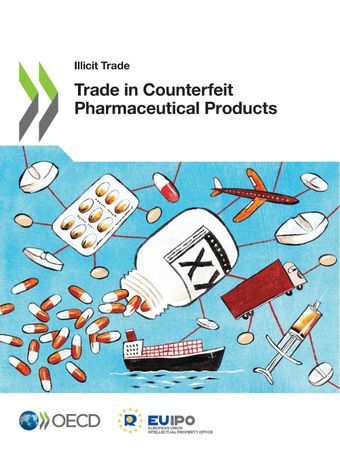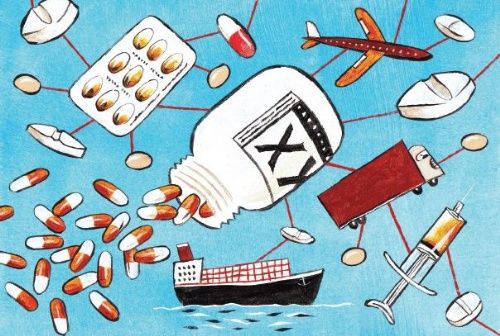Now in its twelfth year, Class 46 is dedicated to European trade mark law and practice. This weblog is written by a team of enthusiasts who want to spread the word and share their thoughts with others.
Click here subscribe for free.
Who we all are...
EUIPO and OECD report on counterfeit pharmaceuticals
The EUIPO and the OECD have published their most recent report on the trade in counterfeit pharmaceutical products. The report is the result of the compilation and analysis of international customs seizures and other enforcement data, together with interviews with experts in industry, trade and customs. It aims to quantify the value, scope and trends in the trade in counterfeit pharmaceutical products. Philippe Bhering of the MARQUES ACPT Team reports.
Industry overview
 The report begins with an overview of industry statistics. In 2018, the global sales of the pharmaceutical sector were estimated at $1.2 trillion, which meant a $100 billion increase from 2017. Sales are expected to increase between 3% and 6% per year until 2023, reaching more than $1.5 trillion.
The report begins with an overview of industry statistics. In 2018, the global sales of the pharmaceutical sector were estimated at $1.2 trillion, which meant a $100 billion increase from 2017. Sales are expected to increase between 3% and 6% per year until 2023, reaching more than $1.5 trillion.
This growth is likely to be driven by the United States, which is expected to account for 40% of the market by 2023. Emerging markets are also likely to experience a strong growth, with sales in China approaching the combined sales of France, Germany, Italy, Spain and the United Kingdom by 2023.
The report also highlights that global trade in the pharmaceutical sector increased both in absolute and relative terms. In 2013, for example, the global value of pharmaceutical product exports amounted to $487 billion, around 2.6% of total world trade in that year. In 2016, the figure was around $500 billion, or around 3.2% of total world trade in that year.
This multi-billion dollar industry also represents a significant share of total employment (between and 0.8 and 1%) in countries such as Switzerland, Slovenia and Denmark. In the United States, with approximately 480,000 people working in the sector, the pharmaceutical industry represents 0.3% of total employment.
Trade mark and patent trends
Still in the same chapter, the report underlines the IP-intense nature of the pharmaceutical industry, which can be measured in terms of both trade mark and patent intensity.
According to data provided by WIPO, the number of trade mark applications for the goods covered by class 5 of the Nice Classification was 390,888 in 2016 compared to 282,311 in 2013. This represents around 4.3% of all world trade mark applications registered that year, and made pharmaceuticals (class 5) the fourth most intense industry in terms of trade mark applications out of the 34 classes of goods in the Nice Classification.
The Chinese Intellectual Property Office received the largest share of trade mark applications in the pharmaceutical sector in 2016 (32%), followed by the Indian Intellectual Property Office (13%), the United States Patent and Trademark Office (5%) and the European Union Intellectual Property Office (3.4%).
The figures for patents are also significant. For instance, the number of patent applications for technology classes concerning the pharmaceutical industry was 108,964 in 2016 compared to 80,214 in 2013. That represents over 4% of all world patent applications and makes pharmaceutical related technologies related the seventh most intense technology field out of 35 such fields recorded by the WIPO. In fact, the report notes that the pharmaceutical sector is one of the most research intensive, accounting for an estimated 22% of all total R&D across all industries in 2018, only slightly less than the computer and electronics sector.
Customs seizures and enforcement actions
Further on, the report presents and analyses data on customs seizures and enforcement actions. In 2016, for example, the international trade in counterfeit pharmaceuticals reached $4.4 billion.
Antibiotics, lifestyle drugs and painkillers were the most targeted by counterfeiters. Other types of counterfeit pharmaceuticals frequently seized by customs authorities worldwide include products marketed as treatment for malaria, diabetes, epilepsy, heart disease, allergies, blood pressure, cancer, and stomach ulcers.
 According to the report, India, China and some Far East Asian Economies, including the Philippines, Vietnam and Indonesia, are the main producers of the counterfeit pharmaceuticals that are traded throughout the world. Hong Kong, the United Arab Emirates and Singapore are the main transit points for counterfeit pharmaceuticals which are then shipped worldwide.
According to the report, India, China and some Far East Asian Economies, including the Philippines, Vietnam and Indonesia, are the main producers of the counterfeit pharmaceuticals that are traded throughout the world. Hong Kong, the United Arab Emirates and Singapore are the main transit points for counterfeit pharmaceuticals which are then shipped worldwide.
Companies registered in the United States are largely those that are most affected by the trade in counterfeit pharmaceuticals, but those in other OECD countries, such as Switzerland, Germany and France, are also strongly affected.
Moreover, according to the report, in terms of volume (total number of customs seizures), mail and courier services are the main modes of transport of counterfeit pharmaceuticals traded worldwide with a share of 96% in the 2014-2016 period. However, in terms of value (global seized value), road transport was the main transport mode, at 43%, followed by mail/courier with 32% and air with 24%.
In this context, the report highlights the growing use by counterfeiters of small shipments, benefitting from the explosive growth in e-commerce. Together, small parcels handled either by postal or express services account for 69% of customs seizures of IP-infringing products for the 2014-2016 period.
The report also highlights the different factors that make the pharmaceutical market so attractive to counterfeiters, classifying them into three categories: (i) “market characteristics”, which determine market potential; (ii) “production, technology and distribution”, which determine the feasibility of counterfeiting; and (iii) “institutional characteristics”, which determine the risks of being caught.
The first category includes the high profitability and the size of the market. In a reported case in the UK, 100,000 counterfeit pills imported at the price of about £0.25 each were being sold for up to £20.00 each, a profit margin of 7,900%. The second category includes the low investment required, the low shipping costs, and the ease of establishing/infiltrating distribution channels. The third category includes the low risk of prosecution as well as the light penalties.
Negative consequences
Furthermore, the report explores the wide range of negative consequences of counterfeit medicines. The impacts are felt by individuals, producers and governments, in addition to the economy-wide effects.
According to the report, estimates show that between 72,000 and 169,000 children may die from pneumonia every year after receiving counterfeit drugs, and that fake anti-malTrebuchet MS medication might be responsible for an additional 116,000 deaths.
Of note also is the estimate that the European pharmaceutical industry lost €9.6 billion in sales due to counterfeiting during 2012-2016, which represented 3.9% of total sales. Another estimate suggests that the cost to EU governments of lost revenue due to counterfeit medicines is in the order of €1.7 billion.
Lastly, the report summarises the main global initiatives taken by international organisations to combat counterfeit pharmaceuticals, including crime-fighting programmes run by INTERPOL and the World Health Organization.
For instance, during Operation Pangea XI, which was coordinated by INTERPOL and took place in 2018, police, customs and health regulatory authorities from 116 countries targeted the illegal online sale of medicines and medical products, resulting in 859 arrests worldwide and the seizure of USD 14 million worth of potentially dangerous pharmaceuticals. Almost 1 million packages were inspected during the week of action, with 500 tons of unlawful pharmaceuticals seized worldwide.
Having presented the figures, the report encourages reflection on policies that could be implemented to strengthen the fight against counterfeit pharmaceutical products.
The full report is available on the OECD website.
Philippe Behring is a lawyer with Bhering Advogados and a member of the MARQUES Anti-Counterfeiting and Parallel Trade Team
Posted by: Blog Administrator @ 08.47Tags: OECD, EUIPO, pharmaceuticals,


 Sharing on Social Media? Use the link below...
Sharing on Social Media? Use the link below...Perm-A-Link: https://www.marques.org/blogs/class46?XID=BHA4857

